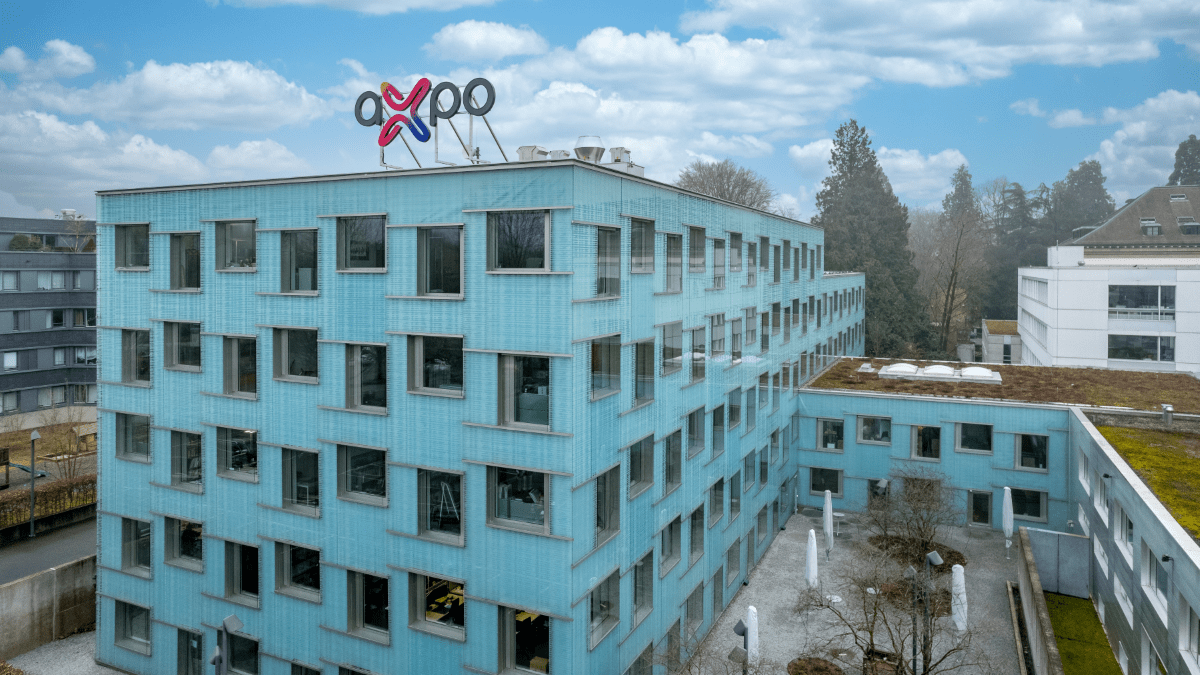A year marked by unprecedented turmoil on energy markets
- Fiscal year dominated by worst energy market turmoil ever seen
- Adjusted EBIT of CHF 392 million (down from CHF 643 million in prior year), result for the period (profit) of CHF 594 million (down from CHF 607 million)
- Annual results depressed by replacement purchases of electricity required due to supply shortfalls and dry weather, as well as by temporary shifts in income
- Massive increase in temporary collateral payments for Swiss electricity production; no drawdown on federal government credit line
- Diversification across fields of business and geographical markets paying off; positive medium-term outlook
- Strong growth in renewables in Switzerland and abroad
- Significant contribution to decarbonisation and energy supply security in Switzerland and Europe
08.12.2022 - Fiscal year 2021/22 was marked by unprecedented turmoil, which is reflected in Axpo Group’s results. Thanks to its strategy of diversification across fields of business and geographical markets and its focus on liquidity management, Axpo was able to weather this ‘perfect storm’. It remained fully self-financing and did not need to draw down on the credit line it had requested from the federal government as a precautionary measure. Axpo’s medium-term outlook is still positive and has been improved by rising electricity prices.
The energy markets experienced turbulence like never before in fiscal year 2021/2022 (1 October 2021 to 30 September 2022), which left its mark on the results of Axpo Group (Axpo). The markets were first hit by price shocks at the end of 2021. From the end of February 2022, Russia’s war of aggression against Ukraine combined with a large number of French nuclear plants going offline and extreme dry weather in Europe to create unprecedented market turmoil, which reached its peak in early September 2022. Wholesale electricity and gas prices were 20 times higher than the average for the past ten years on some occasions. This led to support measures for energy suppliers throughout Europe, as well as other measures to ensure energy supply security.
Christoph Brand, CEO of Axpo: “The unprecedented turmoil on the energy markets meant that we faced huge challenges in the fiscal year just ended. We witnessed the horrors of war in Europe in 2022 – with dramatic consequences for the population affected and a highly negative effect on energy markets. Thanks to the tireless efforts of our staff, our strategy of diversification across fields of business and geographical markets and our focus on liquidity management, we have been able to weather this storm. We did not draw down on the credit line we requested from the federal government as a precautionary measure, and we will do everything we can to ensure that we never need to do so. Axpo’s medium-term outlook is still positive and has in fact been improved by rising electricity prices. We are confident that our three-pillar strategy: focusing on a CO2-free future for Swiss energy, expanding renewables in Switzerland and abroad, and growing our international customer and trading business – will continue to prove its worth going forward. We believe this will allow Axpo to make a significant contribution to energy supply security and decarbonisation in Switzerland and Europe. This year has tested many of our internal processes and systems. Our company will learn from these experiences and emerge from the crisis stronger than before.”
Reduction in hydro power due to dry weather
Axpo’s total income was CHF 10.546 billion, significantly higher than the prior year figure of CHF 6.056 billion. This increase, which largely resulted from electricity and gas price trends, was partially offset by higher expenses for energy procurement. Production from nuclear power plants was down 0.2 terawatt hours (TWh), or 1%, year-on-year at 17.8 TWh, mainly due to the restricted availability of the French nuclear plants. Swiss hydro plants produced 8.2 TWh of electricity, which equates to a fall of 17%, caused primarily by the exceptionally dry summer in 2022. In spite of further expansion in wind and solar power, less favourable wind conditions meant that electricity production from these renewable sources was down 1.7 TWh, or 2%. Electricity had to be bought via the market to compensate for these unexpected shortfalls in production and supply. However, energy repurchased in connection with underproduction in hydro power allowed Axpo to increase storage levels in its reservoirs to high levels ready for the winter.
One-off financial effects in fiscal year 2021/22
Adjusted operating profit (earnings before interest and tax, or EBIT) amounted to CHF 392 million, down from CHF 643 million in the prior year. This sharp fall occurred because the much higher contribution to earnings from Axpo’s Trading & Sales business area and contributions from the sale of wind and solar farms were not enough to compensate for the negative effects of production and supply shortfalls.
Results for fiscal year 2021/22 were influenced by three one-off effects that are not reflected in the adjusted EBIT figure.
- Firstly, the return on funds for decommissioning and disposal of nuclear power plants (STENFO) was -13.6% (compared with +12.4% in the prior year), which reduced the operating result by CHF 327 million.
- Secondly, temporary income shifts in favour of subsequent years that had already been seen in prior periods due to the treatment of financial instruments used to hedge Swiss electricity production under International Financial Reporting Standards (IFRS) totalled CHF 1.470 billion in the year under review. This was caused in particular by the unusual difference in electricity prices between Germany and Switzerland.
- Thirdly, rising electricity prices prompted a review of the valuations of Axpo’s power plants. With future price expectations having risen in addition to current prices, a total revaluation (increase in book value) of CHF 3.150 billion was recorded.
These one-off effects together added CHF 1.353 billion to reported EBIT, bringing it to CHF 1.745 billion. The financial result fell deeply into negative territory (CHF -1,038 million, down from CHF +235 million in the prior year), primarily due to the negative STENFO performance and exchange rate losses on balance sheet items. Income taxes amounted to CHF 113 million, down from CHF 144 million in the prior year. The result for the period (profit) fell from a prior year figure of CHF 607 million to CHF 594 million. In view of the credit line granted by the federal government, no dividend will be paid.
Sharp increase in collateral payments resulting in temporarily high cash outflow
The very sharp increase in collateral payments required in connection with the hedging of Swiss electricity production resulted in a cash outflow from operating activities of CHF 3.117 billion, compared with a cash inflow of CHF 888 million in the prior year. It is important to note that this money will gradually flow back to the company from the next calendar year onwards once the electricity is delivered. Gross investments, primarily in renewable energies, stood at CHF 488 million, with Switzerland accounting for 44%. With divestments totalling CHF 346 million, net investments came to CHF 142 million (prior year: CHF 327 million).
Balance sheet inflation due to rising prices
The extraordinary energy market trends seen in the period under review, including sharp price rises and extremely high volatility, also led to further inflation of the balance sheet. Total assets rose from CHF 44.676 billion as at 30 September 2021 to CHF 79.736 billion as at 30 September 2022. This balance sheet inflation is the result of technical accounting rules that require energy supply contracts and related hedging transactions to be assigned a replacement value, which depends on the market price going forward. This is reflected equally on the asset and liability sides of the balance sheet as the replacement values move in parallel with the market price trend on both sides and fall either when price levels fall or when the corresponding contracts are fulfilled. Total equity as at 30 September 2022 was CHF 7.432 billion, up from a prior year figure of CHF 7.228 billion.
Active capital management
In order to give itself room for manoeuvre financially with regard to the necessary collateral payments mentioned above, the company placed two sustainability-linked bonds worth CHF 500 million each and one sustainability-linked “Schuldschein” (an unsecured debt instrument under German law) worth EUR 600 million during the year under review. Axpo also increased its syndicated, committed credit lines with banks to a total of EUR 6.0 billion up to the end of October 2022 and expanded its bilateral credit lines. Net debt therefore increased from CHF 223 million to CHF 3.644 billion, and liquidity was CHF 4.101 billion as at 30 September 2022.
Strategy of diversification across fields of business and geographical markets paying off
Axpo is driven by a single purpose: to enable a sustainable future for society through innovative energy solutions. Its diversified, three-pillared strategy for doing this (leadership in the transition to a CO2-free future for the Swiss energy industry, expansion in renewable energies and growth in international customer and trading business) has proven its worth even in the current environment. In fact, cash inflows from international business offset the outflows due to the hedging of Swiss production to a considerable extent.
The first pillar of the strategy – playing a leading role in decarbonising Switzerland’s energy supply – is entirely logical, given that Axpo is already the largest Swiss producer of electricity from renewable sources. Axpo welcomes the improved legal framework for photovoltaic (PV) plants in the Alps and has stepped up its ambition in this regard sixfold. The previous target of 200 megawatts (MW) of new solar capacity by 2030 has now been increased to 1.2 gigawatts (GW), around half of which will be built in open spaces, including in the Alps. This solar offensive represents a total investment of some CHF 1.5 billion. An Alpine solar facility is already planned at Val Nalps. In addition to this intensive construction of PV capacity, Axpo is also driving expansion in hydro and wind power, biomass and other technologies in Switzerland.
Investing in the future of energy together with CKW
Axpo’s PV expansion is mainly the responsibility of its subsidiary CKW. Axpo also intends to invest in other technologies up to 2030 in order to generate additional electricity and heat for thousands of households. A number of hydro, PV, wind and cogeneration projects are already under way. CKW has increased the speed at which it is building smaller PV plants by a factor of four compared with 2020. Its specialists in this field installed and commissioned around 600 solar facilities in fiscal year 2021/22. Investments in increased power grid capacity and the nationwide rollout of smart meters are also important for the future of energy.
Strong growth in renewables in Switzerland and abroad
The war in Ukraine has made the second pillar of Axpo’s strategy – expansion in renewable energies – even more important. Axpo is driving progress in alternative electricity generation and storage methods in Switzerland and Europe, to increase their independence in terms of energy supply. Besides the aforementioned activities in Switzerland, Axpo is also a leader in the French solar industry through its subsidiary Urbasolar and significantly grew its solar business in Spain, Italy and Poland during the reporting period. Solar capacity expansion in the period as a whole totalled 247 MW. In wind power, Axpo’s subsidiary Volkswind currently operates primarily in Germany and France. It began developing two wind farms in Romania, with a total of 38 turbines and a combined output of some 250 MW, in the year under review. Axpo’s capacity expansion in wind power during the period amounted to 121 MW. Since Switzerland is physically integrated into the European electricity market and has to import significant quantities of electricity every winter, the construction of further renewable energy production capacity in other countries is also a cost-efficient means of contributing to energy supply security in Switzerland.
Successful customer and trading business
The third pillar of Axpo’s strategy is growth in its international customer and trading business. This delivered good results yet again in the year under review. The focus was primarily on liquidity management due to the challenging environment. Marketing Axpo’s own production (asset-backed trading) makes up a significant share of the business. The electricity generated by Axpo’s Swiss power plants needs an immediate buyer. Trading is therefore inextricably linked to production. However, the electricity Axpo generates in Switzerland is supplied domestically when sufficient demand exists, even though prices are hedged on international markets.
The bespoke customer business (origination) has become a very stable source of revenue for Axpo that is not dependent on the electricity price. Overall, Axpo markets around 14 TWh of solar, hydro and wind power on behalf of its customers. Axpo is ensuring continued growth in renewables through long-term power purchase agreements (PPAs) and helping a number of companies in approximately 40 markets to reduce their CO2 emissions. This business also played a significant role in covering the high liquidity requirement for hedging Swiss production.
Axpo’s proprietary energy trading, while successful, makes up the smallest share of the trading business. Like the entire business, it is subject to stringent regulations and limits. Axpo is among the leading trading partners in a variety of fields and markets, which opens up additional opportunities and helps it to grow in other areas of business. With its know-how and skills in the transport, storage and trading of natural gas and liquefied natural gas (LNG), it contributed to energy supply security in Europe and Switzerland in the reporting year by bringing many LNG deliveries to Europe via Spain. This has enabled Axpo to support the Swiss Federal Office of Energy’s Winter 2022/23 Energy Supply Task Force in its efforts to find energy supply security solutions amid the current challenges.
Additional measures to ensure energy supply security
Faced with the threat of electricity shortages, Axpo has taken various measures to shore up Swiss energy supply even further, including interrupting the renovation work on the Gigerwald dam in the Tamina valley (Canton of St. Gallen). While this work is essential, and interrupting it is very costly, Axpo wanted the output of up to 160 GWh from the water stored in the reservoir and from recirculation to remain available, given the threat of shortages. It has also kept more water back during 2022 despite the dry weather in anticipation of such shortages, shifting enough capacity to generate around 1 TWh of electricity into the winter.
Hedging strategy adjusted; PwC assessment confirms adequate risk management
Events in the reporting period were truly without precedent. At the start of 2022, the financial repercussions of this ‘perfect storm’ caused Axpo to pause, review and revise the hedging strategy it had successfully employed for its electricity production since it was signed off by the Board of Directors in 2013. The full impact of this will only become clear over time as existing contracts are gradually fulfilled. Axpo’s Board of Directors also tasked PricewaterhouseCoopers (PwC) with carrying out a third-party assessment of its overall risk management, and in particular the events that led to the precautionary request for a credit line from the federal government. PwC’s experts concluded that Axpo has controlled its market risk adequately in line with normal market practices over the past year, that high liquidity requirements were primarily the result of hedging in relation to Swiss production in view of record-high price levels, and that the international customer and trading business reduced net cash outflows considerably.
Outlook: positive medium-term effects from higher electricity prices
The uncertainty over the effects of the war in Ukraine and political intervention in the international energy markets makes forecasting difficult at present. Axpo expects the income shifts cited above to have a positive impact in the coming years, with higher electricity prices also bolstering the annual accounts from fiscal year 2024/25. Over time, the money tied up as collateral will also flow back to the company. Fluctuations in the value of the STENFO funds and the securities portfolio, meanwhile, will continue to influence earnings.
Key figures for 2021/22
(1 October 2021 to 30 September 2022)
| 2021/22 | 2020/21 |
Total income | 10 546 | 6 056 |
Earnings before interest and tax (EBIT) | 1 745 | 516 |
as % of total income | 16.5% | 8.5% |
Adjusted EBIT | 392 | 643 |
as % of total income | 3.7% | 10.6% |
Result for the period (profit) | 594 | 607 |
as % of total income | 5.6% | 10.0% |
Cash flow from operating activities | -3 117 | 888 |
Net investments in non-current assets | -142 | -327 |
Total assets | 79 736 | 44 676 |
Net financial assets | -3 644 | -223 |
Equity including non-controlling interests | 7 432 | 7 228 |
Employees (full-time equivalents) | 5 937 | 5 338 |
About Axpo:
Axpo is driven by a single purpose – to enable a sustainable future through innovative energy solutions. Axpo is Switzerland's largest producer of renewable energy and an international leader in energy trading and the marketing of solar and wind power. Axpo combines the experience and expertise of more than 5,000 employees who are driven by a passion for innovation, collaboration and impactful change. Using cutting-edge technologies, Axpo innovates to meet the evolving needs of its customers in over 30 countries across Europe, North America and Asia.
- Media release View Send email Download
- Image Send email Download
Axpo Holding AG
Corporate Communications




